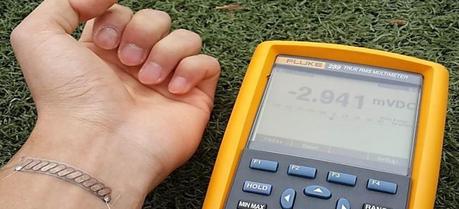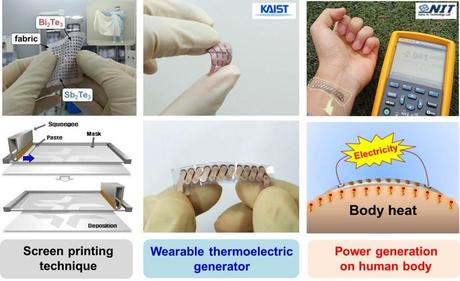 A thermoelectric generator developed as a wristband. The generator can be easily curved along with the shape of human body. (Credit: KAIST)
A thermoelectric generator developed as a wristband. The generator can be easily curved along with the shape of human body. (Credit: KAIST)A team of researches at KAIST University, Korea, has developed a glass fabric-based flexible thermoelectric generator that is extremely light and produces electricity from the heat of the human body.
The new generator developed by a team headed by Byung Jin Cho, a professor of electrical engineering, could provide power for wearable electronics in a stable and reliable manner.
To date, two types of thermoelectric generators have been developed based either on organic or inorganic materials. The organic-based thermoelectric generators use polymers that are highly flexible and compatible with human skin, ideal for wearable electronics. The polymers, however, have a low power output. Inorganic-based thermoelectric generators produce a high electrical energy, but they are heavy, rigid, and bulky.
Professor Cho came up with a new concept and design technique to build a flexible thermoelectric generator that minimizes thermal energy loss but maximizes power output. His team synthesized liquid-like pastes of n-type (Bi2Te3) and p-type (Sb2Te3) thermoelectric materials and printed them onto a glass fabric by applying a screen printing technique. The pastes permeated through the meshes of the fabric and formed films of thermoelectric materials in a range of thickness of several hundreds of microns. As a result, hundreds of thermoelectric material dots (in combination of n and p types) were printed and well arranged on a specific area of the glass fabric.

The picture shows a high-performance wearable thermoelectric generator that is extremely flexible and light. (Credit: KAIST)
Professor Cho explained that his flexible thermoelectric generator has a self-sustaining structure, eliminating thick external substrates (usually made of ceramic or alumina) that hold inorganic thermoelectric materials. These substrates have taken away a great portion of thermal energy, a serious setback which causes low output power.
He also commented, “For our case, the glass fabric itself serves as the upper and lower substrates of a TE generator, keeping the inorganic thermoelectric materials in between. This is quite a revolutionary approach to design a generator. In so doing, we were able to significantly reduce the weight of our generator (~0.13g/cm2), which is an essential element for wearable electronics.”
When using KAIST’s flexible thermoelectric generator (with a size of 10 cm x 10 cm) for a wearable wristband device, it will produce around 40 mW electric power based on the temperature difference of 31 °F between human skin and the surrounding air.
Professor Cho further described about the merits of the new generator:
“Our technology presents an easy and simple way of fabricating an extremely flexible, light, and high-performance TE generator. We expect that this technology will find further applications in scale-up systems such as automobiles, factories, aircrafts, and vessels where we see abundant thermal energy being wasted.”

